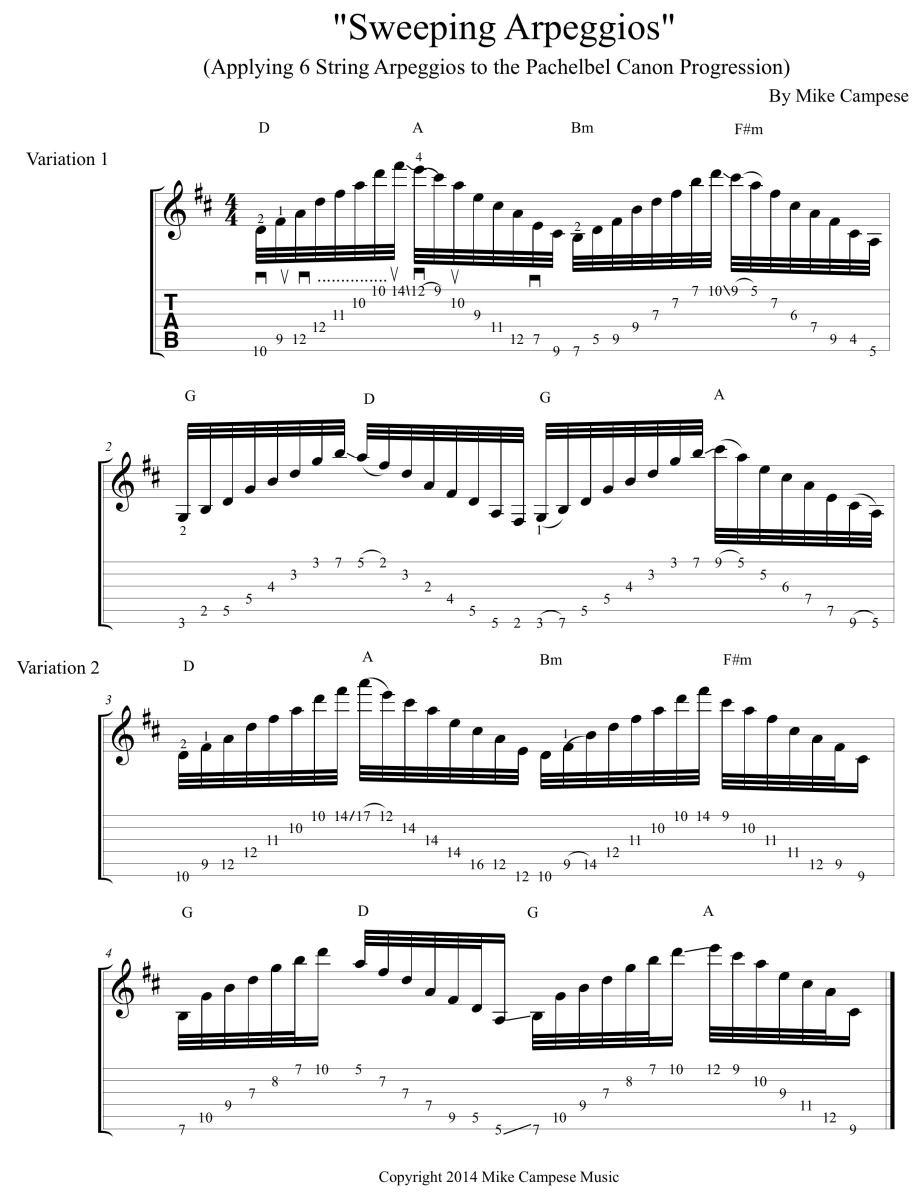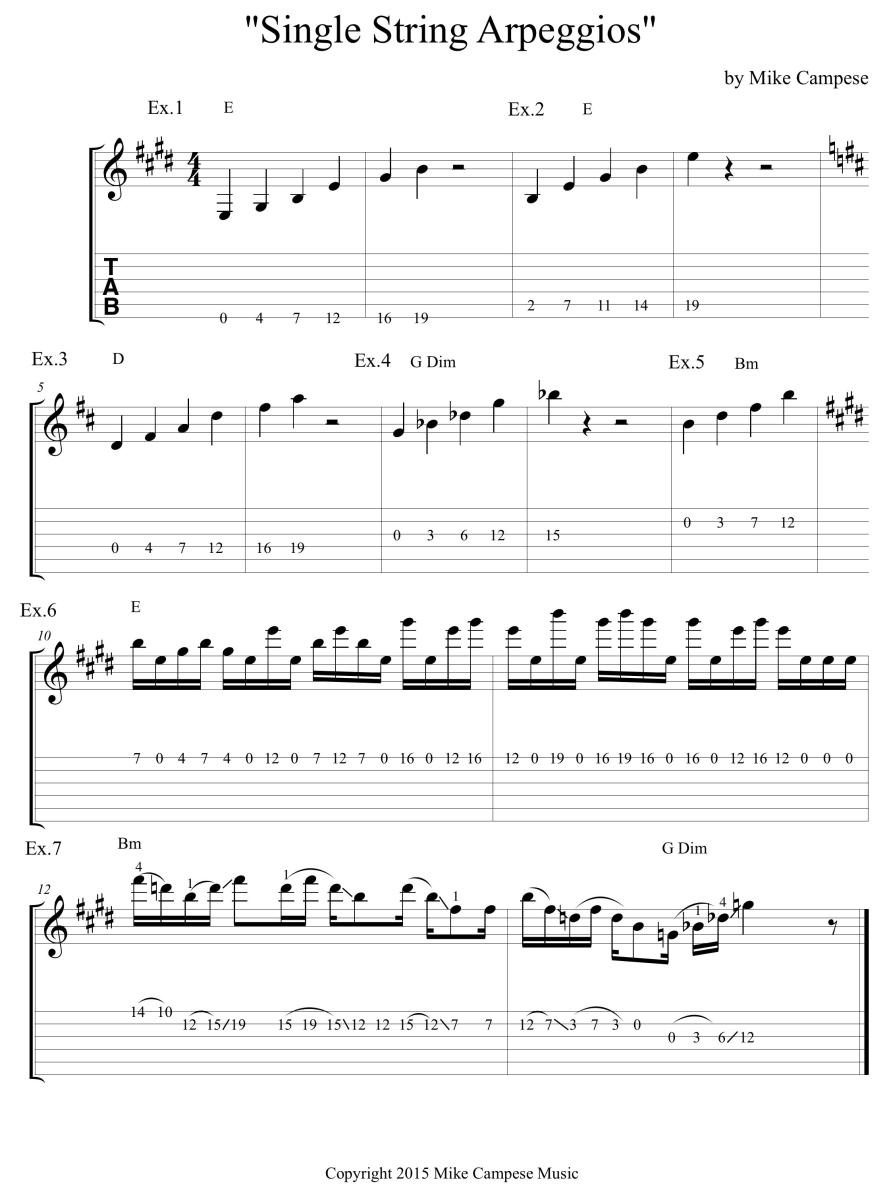Welcome back! In this lesson I would like to give you a nice sweep picking arpeggio workout using the chord progression from Pachelbel's Canon in D. I felt this is a common and a great progression to apply these arpeggios too and it will help you learn how to apply it to other progressions as well. All the arpeggios are played on all 6 strings of the guitar and are major and minor triad type arpeggios. We won't go too in depth with the theory, this assumes that you know your basic arpeggios and how they are built. If you are not sure of the interval structure of the arpeggios, they are major (1, 3, 5) and minor (1, b3, 5) - for example the notes in a D major triad will be (D, F#, A).
The chord progression for this piece is (D, A, Bm, F#m, G, D, G, A). A lot of these arpeggios are common 5th and 6th string shapes linked together that use all 6 strings across the neck. This arpeggio progression is divided up into 2 parts, bar 3 begins the second variation of arpeggios and it is the same progression just played in a different way. I move up a little higher on the neck and link different arpeggios shapes together across the neck. If you are new to sweep picking, go slow at first and be sure that you are playing all of the notes very clean and even. It is important not to let the notes run together like a chord, it will sound messy. Also, I put a few right hand picking symbols in the beginning that I use for most of the arpeggios, but be sure to experiment with your own.
MP3 - Sweeping Arpeggios

Be sure to apply this concept to different pieces and and don't forget to check out my latest CD, "Chameleon". and please visit mikecampese.com for more information.Happy New Year! In this lesson I would like to show you some single string arpeggios (arpeggios played on one string), and we will be focusing on triad arpeggios for this lesson. Triad arpeggios are built with just three notes and you should know these in all keys. For this lesson we will be focusing on major, minor and diminished arpeggios. You should know the formulas for these triads inside and out. If you are not sure of the formulas, the formula for a major arpeggio is (1, 3, 5), the minor formula is (1, b3, 5) and the diminished arpeggio is (1, b3, b5).
For the first handful of examples in this lesson, I will be giving you a few basic arpeggios on one string at a time and it is up to you to use your imagination and play them everywhere on the neck.
Example 1 is an E major arpeggio (E, G#, B) on the low E string. The E is open, the G# is on the 4th fret, the B is at the 7th fret and it repeats at the 12th fret up an octave.
MP3 - Single String Arpeggios, Example 1
Example 2 uses the notes of the E triad on the A string - be sure to continue these same notes on all strings.
MP3 - Single String Arpeggios, Example 2
Now, with Example 3 we have a D major arpeggio (D, F#, A) on only the D string. Again, learn these notes on all strings as high or low on the fretboard as you can.
MP3 - Single String Arpeggios, Example 3
Example 4 is a G diminished arpeggio (G, Bb, Db) on the G string. The G is open, the Bb is at the 3rd fret and the Db is at the 6th fret etc.
MP3 - Single String Arpeggios, Example 4
In Example 5 we have a minor triad - a B minor arpeggio (B, D, F#) on the B string.
MP3 - Single String Arpeggios, Example 5
Example 6 is an example on how you could construct ideas with these single string arpeggios. This is a E major arpeggio pattern played on the high E string, using open strings. This pattern repeats up the neck and you can change it up in many different variations.
MP3 - Single String Arpeggios, Example 6
Example 7 is another way you can use arpeggios on a single string, with incorporating slides. This is a B minor arpeggio that is mainly played on the B string and then it goes to a G diminished arpeggio on the G string. You could stay entirely on one string for all the arpeggios if you want, but it is cool to mix it up as well.
MP3 - Single String Arpeggios, Example 7

That is it for this lesson! Be sure to make up your own single string arpeggios and don't forget to visit mikecampese.com for the latest info and to purchase my latest CD, "Chameleon".
Mike Campese is an all-around music performer, session artist and teacher competent in many musical styles, electric and acoustic. He has studied at G.I.T. (Honors Graduate), and with Paul Gilbert, Norman Brown, Stanley Jordan, Scott Henderson and Keith Wyatt.